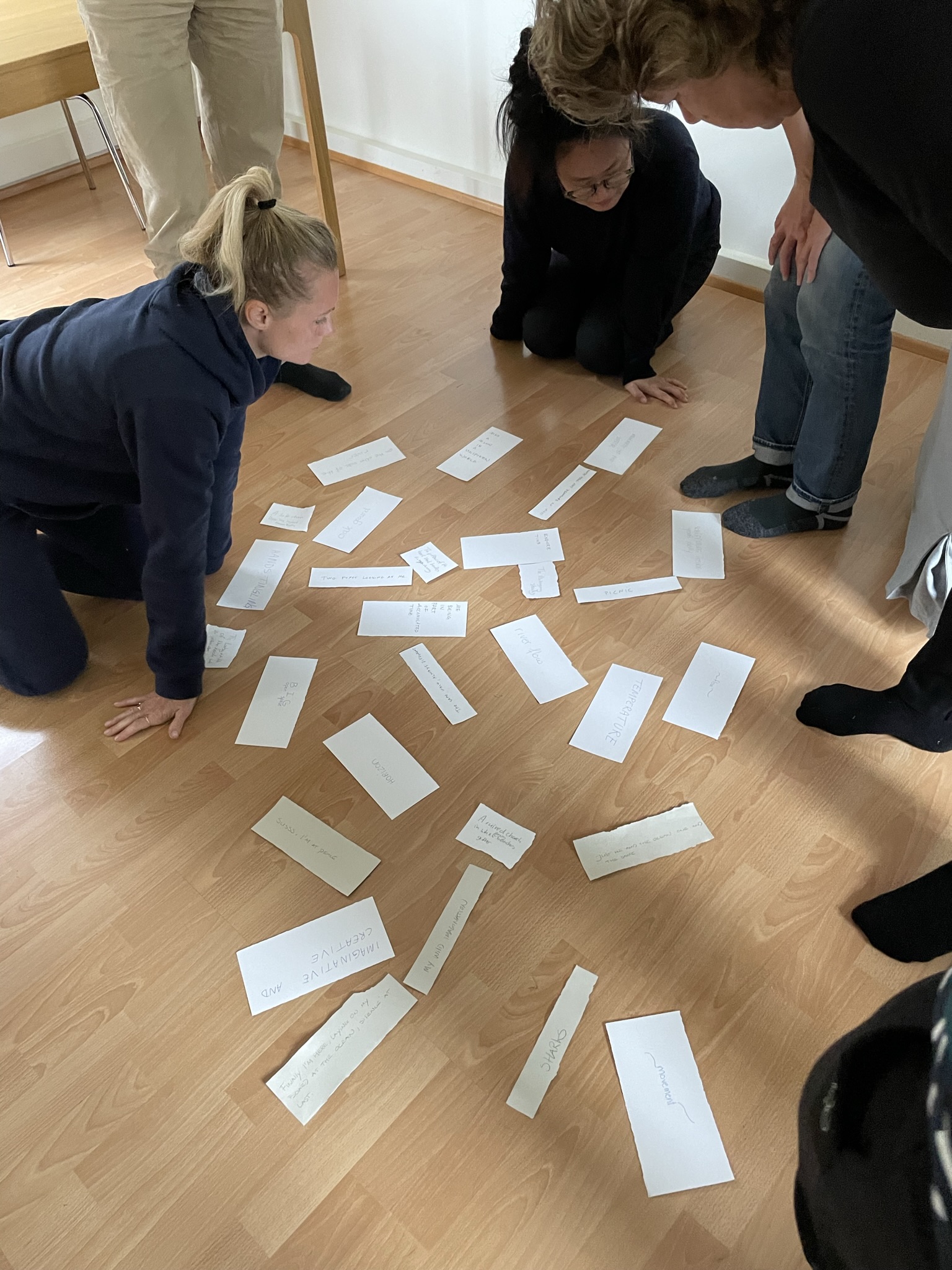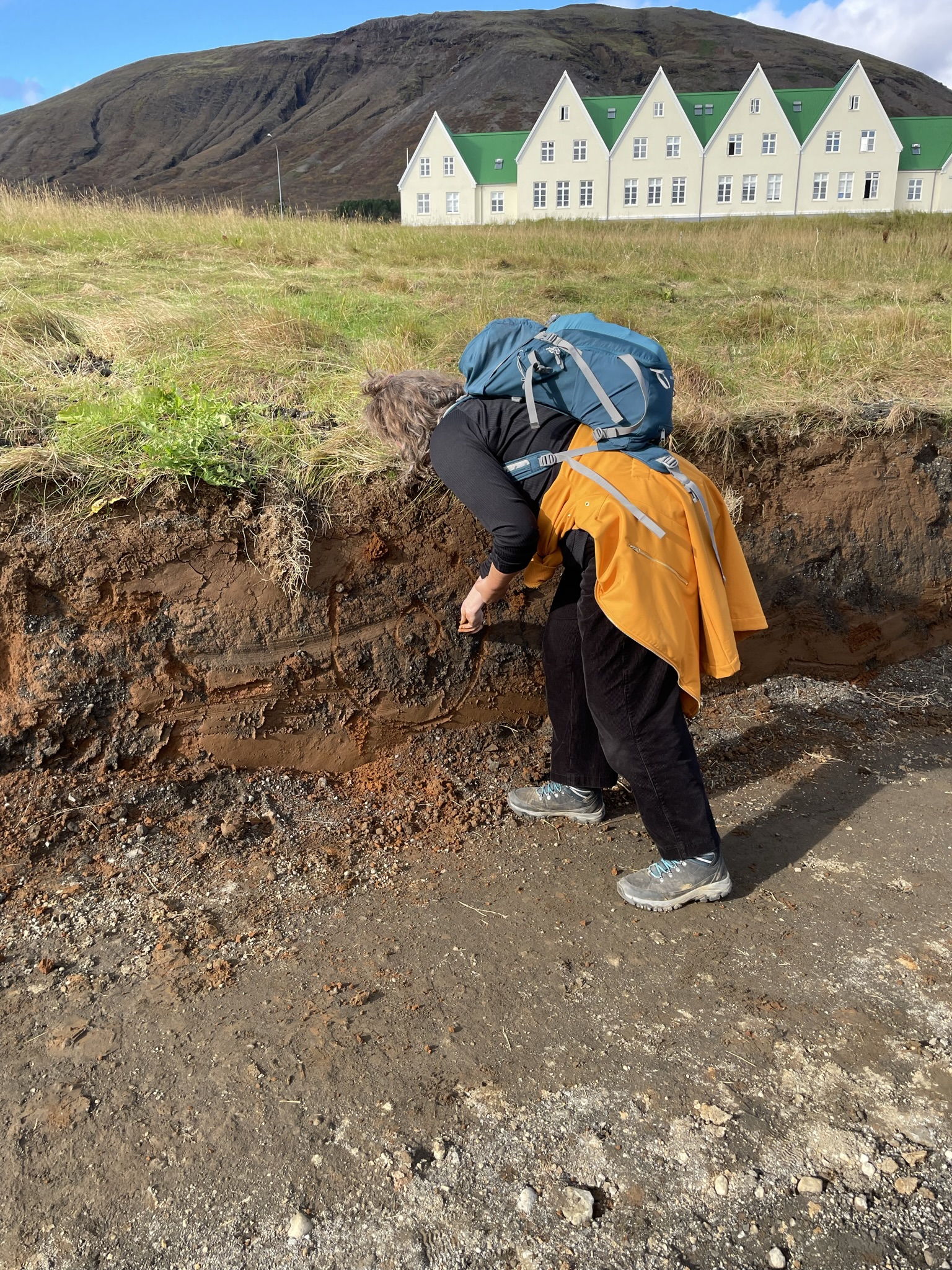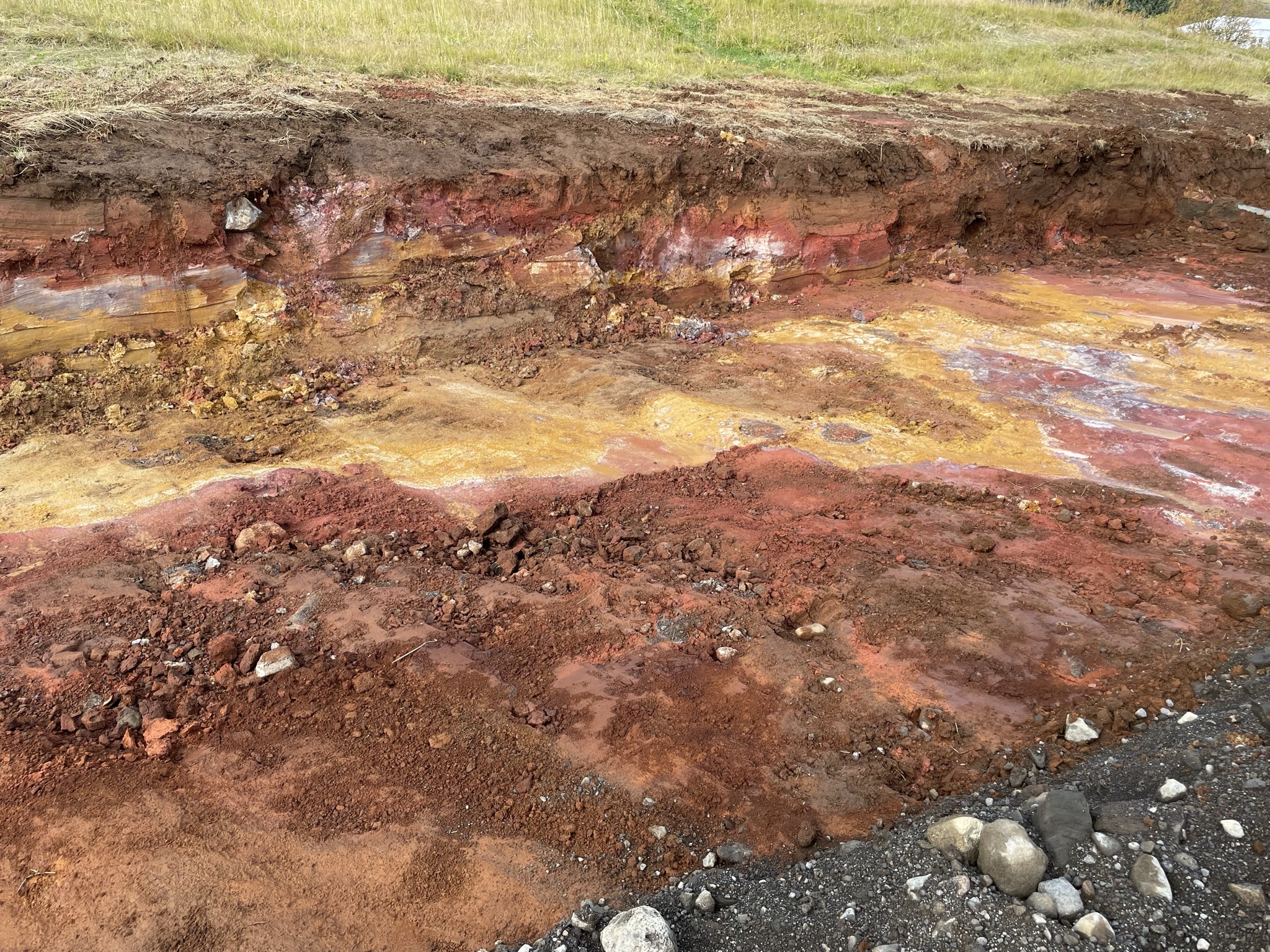From 19-23 September 2022, six master students and two teachers from UiA`s Master Program of Fine Arts, Kristiansand, participated in PIMDI`s gathering in Iceland.
The research project PIMDI (A Pedagogy of Imaginative Dialogues), consists of students and researchers from Finland, Norway, The Netherlands and Iceland, and is a part of the Erasmus Program Strategic Partnership of four European master programs of Arts Education:
• the Master of Education in Arts at the Hanze University of Applied Sciences in Groningen, a joint degree with NHL Stenden University at Leeuwarden/The Netherlands
• the Master Arts Education at the Iceland Academy of the Arts in Reykjavik/Iceland
• the Master Fine Arts at the University of Agder/Norway
• the Master Theater pedagogy and Dance pedagogy at Uniarts Helsinki/Finland
The starting point of the PIMDI project is the idea that in Europe there is something called ‘the paradox of democratization’. The European Union is a democratic government which means that it is based on principles of equality among European citizens, but as it now encompasses 27-member states, the challenge is to bring all these different voices together in the enactment of values that people recognize as more or less their own or as interestingly different.
The goal of the PIMDI-project then, is to explore and develop a pedagogy of imaginative dialogue and so we experiment with the arts as a way of creating dialogues without trying to eliminate differences. PIMDI started during the covid pandemic with gatherings online and in fall of 2021 commenced for the first intensive study week in Helsinki, Finland. The second intensive study week was in the spring of 2022 in Kristiansand, Norway.
Six master students from the Master’s programme in Fine Arts at UiA https://www.uia.no/en/studieplaner/programme/MASTKUN were invited to participate in this third intensive study week in Iceland where our role was to be both students and co-researchers. As co-researchers we participated, documented, and reflected on the activities during and after the week, and thus provided important material for the research part of the PIMDI-project
In all the gatherings there have been different topics or themes for the intensive week and time to develop an artistic project engaging natives of the respective countries. In Finland, the students developed and engaged with elderly and dementia patients while in Norway we engaged with young pupils at the public culture school “Knuden”. In Iceland the focus was on youth in highschool, 15-18yrs old. The theme of the Icelandic encounter was to engage our bodies with nature and explore what dialogue would emerge from it.
On the first morning we gathered at the University of Fine Arts in Reykjavik to hear a lecture by Gudbjørg Johannesdottir, she was speaking on the inner landscape of the body; the phenomenology of thinking. She talked about how our bodies are always somewhere and that they are constantly gaining knowledge, having an imaginative dialogue with the landscape or nature surrounding them, and so set the tone for the rest of the week.
Skalholt
The next four days we spent at a campground in the south of Iceland called Skalholt. It was situated on an open, wide field within walking distance from a cathedral of historic importance to Iceland, but not much else at first glance. Plains surrounded us and every morning before breakfast we were summoned to stand outside in the grass, barefoot or with shoes, and contemplate our surroundings for 20 minutes; what our feet were resting on, what our eyes were seeing, how the wind was blowing, and every morning a flock of white swans came gliding over our heads; calling as they stayed in formation or quietly letting us hear the sound of their strong wings.
Imaginative dialogue was explored in many ways with the surrounding nature; visiting outdoor hot springs, hiking in the landscape, being in the rain or digging in the dirt; it all affected us in various ways. One student reported: I’m so used to seeing nature that the campground really wasn’t that impressive to me, but when we were doing outdoor projects, I started to feel nature on a deeper level; in the calming of the silence, and the freshness of the air.
Another student said: The Icelandic nature made a big impact on me since it was quite different from Southern Norway where we have a lot of trees. The green, very open landscape, covered by almost only moss and lava rocks, and very few small trees, were charming and unique. I felt like I got closer, more conscious about and a quite personal relation to nature. The morning rituals were about being in the present, being totally calm, contrary to our everyday lives where we always rush from one place to another, and simply don’t really offer any time to only be in the moment and meditate; listening to the beautiful sounds of nature. For me it was so interesting to look at the others and see what kind of relationship they had to nature, and how they opened up and behaved themselves in the different assignments like in the morning ritual. Some closed their eyes, and made small movements like rocking, some laid down in the wet grass.
To me it was challenging to be “out of myself” and be so free, relaxing totally, because I was too obsessed with being seen although I knew that nobody cared, or that it was ok to do so. Maybe it’s a good exercise for me to try to relax and not be so obsessed by what others might think about me. Anyway, I think it has to do with age as well, but still I think that the different assignments combined with nature were really liberating and inspiring and it was so informative to see how the others thought and solved the tasks.
The workshops and exercises
The students carried out various individual and group tasks in Skalholt. In one of the workshops the task was that participants had to write down words and sentences on a piece of paper and work together to create a story, poem or song. Another exercise we participated in was to think about a tactile object and write a text about it. Each of the participants read out their text to the group in turn. The text should not reveal what the object was and as they listened in, the others in the group drew what they thought was being talked about. In the end we compared drawings and tried to guess which object the narrator had described.
The picture below of a handwritten note is from one of the small-group sessions on language and embodiment. We would all write down impressions on small notes of paper and take turns placing them in order. It became a very organic way of co-creating a common experience as well as the text living its own life, changing all the way. In the end we experimented with reading it backwards and from random starting points, as it was laid out in a circle, all giving different perspectives on our common and diverse experiences.

Drawing trees
In one of the exercises we had to choose a tree that we were drawn to in the forest , lay down on the ground under the tree and put a drawing paper on our chest and draw what we saw without looking at the paper. It was really interesting because you could not correct yourself. It could be spruce, clouds, bark etc. Afterwards there was an interesting discussion about the unconscious when the group met to compare the drawings and experiences. The result told a lot about people’s different ways of looking at and evaluating what is important or unimportant in each individual’s experience laying under a tree in the rain drawing…
Mountain Hike
An important experience to me, another student wrote, in the intensive week in Iceland was the mountain hike together with a partner with whom I had not talked much with earlier in the week. We were given the task of creating a sentence that would describe the PIMDI-project and what it meant to us subjectively. It was not a goal that the partners agreed on the sentences. I walked with my partner both up and down the mountain where we discussed what our sentences would be while simultaneously taking in the beauty around us; the colors, the soft moss, the progress of autumn, the beautiful view, the meaning of water, berries and details on small plants along the narrow paths.
Radical Listening
Another interesting exercise we did every day in Skalholt was “Radical Listening”, which we hope will be continued at the next intensive week in the Netherlands in the spring. Radical listening is when two people are having a conversation in a new way. The speaker speaks continuously for 8-10 minutes about an issue or a theme in their life. The listener empties her head of other thoughts and listens actively to the speaker observing and noting/drawing the speaker’s non-verbal body language and important keywords of the talk. Afterwards, the listener and speaker look at the notes and have a short conversation about the session before the roles are reversed. Among other things, this session was about listening, reflecting and encouraging non-verbal communication as well as building relationships within the group. Everything that was shared in the Radical Listening sessions were confidential and every day we chose a new conversation partner. One student noted; I felt that when I did the speaker’s role, it was also a kind of listening. In a way it gives me time to feel and listen inward and also find the words from the heart. Instead of being interrupted, I experienced support from the listener, that they just were there in the present with you. Personally, I think it was very liberating with a frame around the conversation where there’s no opportunity to complete other people’s sentences. Radical Listening as well as other ways of imaginative dialogue is about how I can use myself in dialogue with a person or a group. I bring everything I am, everything I know and all my experiences into the collaborations with fellow students. I am always one person/a subject, but I use the lessons learned from the PIMDI project to communicate in new ways. I experience that now I will have more freedom to use my imagination to e.g. present a student project. I see that people or myself often compare ourselves to those we listen to in order to resonate with our own perception – in such a way that you can almost measure the words that come out from the other person or myself when talking, and must meet in agreement with the other.
Being listened to without being interrupted, silence and pauses between your own words, being able to recognize what you want to share meaningfully in such a way that you get to speak from a place that feels truer and not on autopilot. As a student, and as a human I think it is a good quality to practice for yourself and together with others. Living, listening and speaking from a true place is certainly something I want in my relationships, art and in life in general. By listening you get a completely different experience of what is being said than if you think of just waiting for your own turn to talk, you can feel the words and what is being said in a very present way. Feeling listened to is also something that is significant and important to all kinds of people, I think.
Art Walk
One of the themes was being in nature with silence, no talking or conversations. We were going to explore and find out how we wanted to discover that together. We had just returned to Skalholt after a hike in the mountains. After we split into groups, there were four people in my group, with “no talk” and silence as a topic. It was as if we all agreed right away how we wanted to explore it together. I sensed a very good and pleasant dynamic in the group, where I felt safe and that I could be myself.
The Art Projects
It was interesting how we don’t need 3 days to plan an art project with pupils. My group of students got to talk very little together about what we were going to do with the students, because we cooked dinner for hours and the next day we packed our suitcases and cleaned before leaving for the school where we met the pupils. We are adults with life experience and pedagogic expertise that we used in our impromptu conversation and play with the students.
One of the groups (3 students and 3 pupils) had discussions about art, and played with clay, natural materials and water.


My group arranged a drawing assignment where the task was to, within a limited area, the school area, find a place that you really like! First; draw this place with artificial colors (oil crayon), then with what you find in nature. The pupils could choose to draw the way they wanted, abstract, detailed, etc. After we all were finished, we looked at all the drawings and talked about them in the group. It was interesting to see the diverse results.
At night the students and teachers impulsively organized several dance and music collaborations as small happenings. We found a community through dance and music where everyone could freely express themselves as they felt in dancing, singing and playing instruments. Those who were not interested were free to do other things like look at the stars, have bonfires or play games in the living room.
Conclusion and ending
The time spent in the countryside where nothing was happening helped facilitate deep conversation and friendships during the short week we were together. To be in nature, from the meditation practice in the mornings to the hike to ”Vardafjell”, to seeing the glow from the greenhouses at night on the low clouds, grounded us and helped us listen actively as well as share in the radical listening sessions. The small group exercises in a similar way created a community as we worked together with nature, words, music and movements to co-create pieces of art and artistic expressions. These experiences are knowledge we will bring home with us to implement in our own practises and teaching vocations. Our bodies were experiencing being somewhere, gaining knowledge intuitively, words would not be able to explain in a 1000 years. Nature; the surrounding fields, mountains and streams became known and very valuable to us as we engaged with them in a sort of imaginative dialogue. These experiences and learning outcomes were very different for each participant and perhaps that is the most important point. Even if you gather a group in similar surroundings with similar tasks, they all give and take and relate differently, proving that there is room for everyone and that different skills and perspectives are welcome and needed to create a functioning, exciting collective. Experiencing this opens for the courage to be oneself and find possibilities in a group as well as challenging each other and ourselves. Somewhere in this negotiation of space and expectations may be the ways to exist in the paradox of democratization.